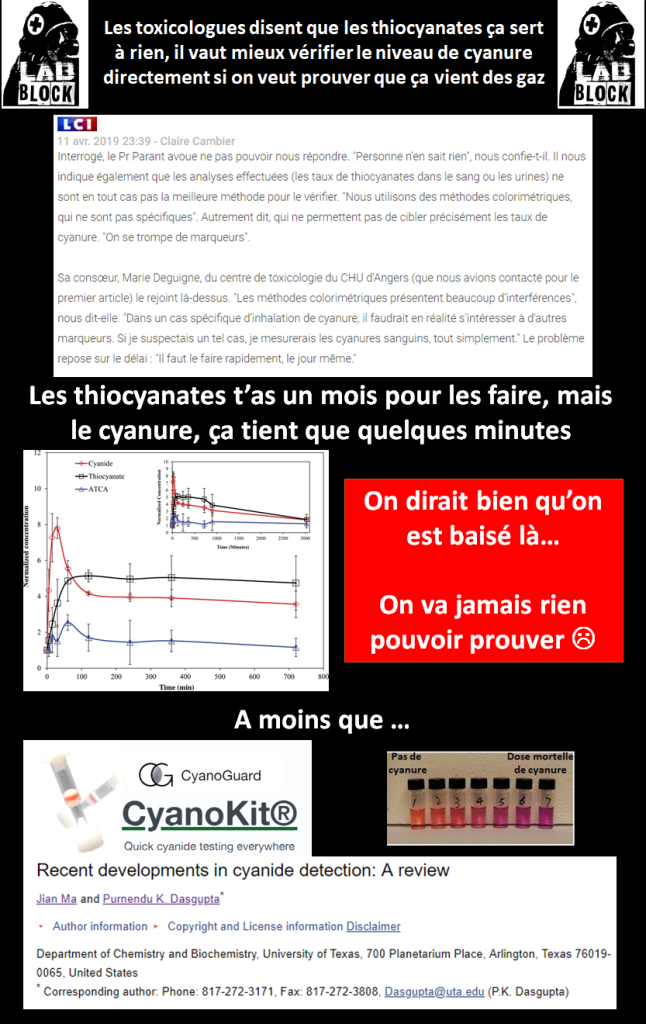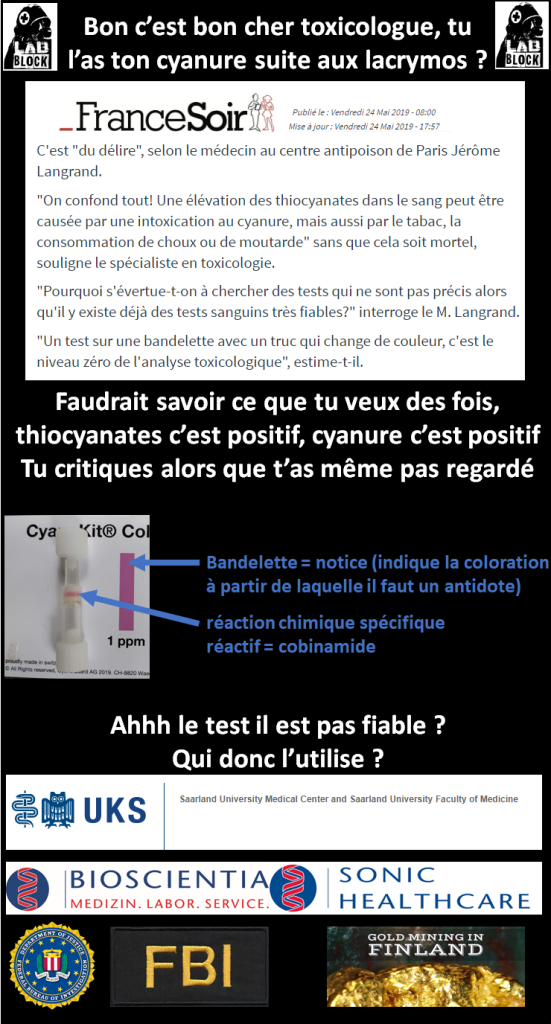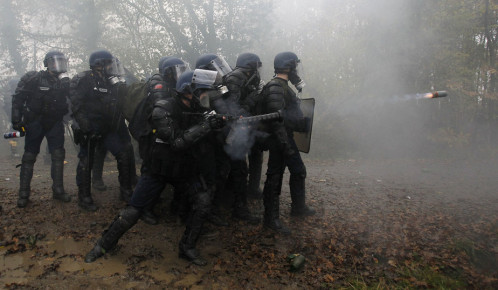https://www.facebook.com/MetropolitainFR/videos/1279735262193085/
Tous les articles par alex
Gazage d’enfants
Gaz lacrymogène et santé
Je regarde un transfert d’une journée d’événements à Paris, via RT. Grâce à la technologie moderne, tout ce qui se passe se fait simplement sentir dans ma chambre. Bien pas tous. Je ne peux pas sentir le gaz lacrymogène, mais comme je tombe dans ceux qui n’ont pas peur de dire ce qu’ils pensent, il suffit de suffisamment de cassettes pour se souvenir du jour où je l’ai inhalé dans la rue. Puis, lorsque les yeux sont enflés et flous, peu de gens ont déjà pensé à ce qu’est une larme. Ensuite, il est seulement important d’arrêter la douleur et de voir. Normal
Maquereau ou lacrymatoire Le gaz qui pleure appartient aux armes chimiques. On peut affirmer que cela ne sert qu’à disperser les manifestants et à ajouter leur version de leurs traits – maudits, sales, voyous, gens, héros. Déjà par affinités personnelles. Il existe plusieurs types de gaz lacrymogène, à savoir: – Spray au poivre – Spray de Pava – gaz CS – gaz CN – gaz CR Le spray au poivre est principalement destiné à un usage personnel comme défense contre les attaques et est composé de piments forts et de poivrons, qui sont ajoutés au maïs. Tout est naturel, n’est-ce pas? PAVA spray est utilisé par la police britannique. Il s’agit d’une solution à 0,3% de vanillylamide d’acide pélargonique (PAVA), de capsaïcinoïde synthétique, d’éthanol et d’azote sous forme de gaz. Il est généralement utilisé à faible distance et agit sur les yeux, provoquant une douleur intense et obligeant à fermer les yeux.
Le gaz CS est le 2-chlorobenzalmalononitrile (également appelé o-chlorobenzylidène malononitrile; formule chimique: C10H5ClN2) et le cyanocarbone, qui sont tous stockés dans des cartouches. Cause une sensation sévère dans les yeux avec fermeture, larmes, nausée, désorientation, fermeture nasale, démangeaisons, toux et difficulté à respirer. La police exprime son amour pour les manifestations. Le gaz CN est du chlorure de phénacyle, également connu sous le nom de chloroacétophénone, peut être synthétisé par acylation de Friedel-Crafts du benzène en utilisant du chlorure de chloroacétyle, le chlorure d’aluminium servant de catalyseur. Il a été considéré qu’en raison de sa toxicité prononcée, il ne serait pas utilisé, mais, comme toujours, le mal causé par l’homme prédomine et fait partie du spray MACE connu. Il est le favori des formations paramilitaires. Le gaz CR ou dibenzoxazépine a été mis au point par le ministère britannique de la défense. Il est dix fois plus efficace que le reste et est cancérigène. Il est également mentionné par la Human Rights Association. Il irrite la peau, crée des attaques de panique, des suffocations, un combat aérien. Utilisé à l’intérieur, il peut provoquer la mort par étouffement et un œdème des poumons.
Effets sur la santé
L’utilisation de gaz lacrymogène a été considérablement envahie par la végétation ces dernières années. Il est utilisé dans les villes densément peuplées, telles que Le Caire, Istanbul, Rio de Janeiro, Manama (Bahreïn) et Hong Kong. Également dans les émeutes à Ferguson, dans le Missouri. L’utilisation de gaz lacrymogène entraîne de nombreux problèmes de santé qui peuvent être aigus et chroniques. Aigu Ce sont des effets immédiats après l’utilisation et le but de l’utilisation est d’induire ces effets. Irritation des yeux, de la bouche, du nez, de la peau et du système respiratoire. Les effets cutanés comprennent la douleur, des démangeaisons, des rougeurs et une possible dermatite de contact allergique. Déchirure oculaire (oculaire), démangeaisons, blafarospasme, douleur, rougeur et sensation de brûlure.
Respiratoire
Les effets sur le système respiratoire et leur histoire sont un exemple passionnant de mauvaise science. Afin de prouver que les larmes étaient inoffensives, des études ont été menées sur des animaux de laboratoire et une étude sur des soldats volontaires en bonne santé n’a été réalisée que sur sept sujets; tous ceux ayant déjà eu des problèmes respiratoires étaient exclus de l’étude. Ce n’est pas comme ça. Toutes les études comparent les résultats avec des personnes qui ont déjà été exposées à une activité de l’acide lactique plutôt que de manière chronique. C’est comme beaucoup d’autres agents si seulement de petites doses sont comptées. Cependant, qu’en est-il des expositions chroniques et en Turquie, par exemple? Personne ne conteste les effets actuels, ils ne peuvent pas le voir. D’autre part, si nous introduisons dans l’équation d’un groupe à risque tel que les fumeurs, ceux qui sont plus exposés au radon, les fumeurs plus exposés au radon, les personnes asthmatiques, souffrant de douleur obstructive pulmonaire chronique et d’autres maladies pulmonaires chroniques, obtiennent toutefois des résultats différents. Quelqu’un dira – et que feront-ils lors des manifestations? – et ce ne sera pas juste. Le droit humain fondamental est de se rebeller contre ce qui est considéré comme une injustice.
Des manifestations massives en Turquie ont montré que des problèmes respiratoires importants tels que l’apnée, l’œdème pulmonaire, des arrêts respiratoires et une hémoptysie se produisaient. Trouver chez les femmes était pire que chez les hommes. En ce qui concerne les zones densément peuplées, les locataires environnants étaient chez eux. Une étude plus sérieuse a montré que des problèmes respiratoires chroniques se sont produits chez 55 personnes sur 93 ayant été exposées au gaz lacrymogène plus d’une fois. L’effet primaire prolongé est la bronchite chronique. Problèmes respiratoires chez le personnel militaire Les militaires sont exposés à de nombreuses déchirures lors de leur entraînement régulier. La vérité est qu’ils ont un masque à gaz, mais cela ne signifie pas que chacun d’eux fonctionne parfaitement. Les effets chroniques sont la toux, les maux de gorge, la sinusite, la rhinopharyngite, la bronchite et autres. Les problèmes augmentent surtout après la grippe. Comme ce problème dure longtemps, la quantité de gaz utilisée est réduite. Maintenant, ce n’est pas clair pour moi, s’ils connaissent le problème, pourquoi nient-ils que des civils puissent être blessés?
Effets sur les yeux
Il est logique que les yeux d’une étoile à gaz lacrymogène. C’est leur but. Cependant, si l’objectif d’invalidité temporaire ne devrait pas être l’objectif de blessures permanentes. La haine pour d’autres idées est-elle si forte? Lésion oculaire, œdème stromal, dépression conjonctivale, injection de vascularisation oculaire profonde. Autres complications oculaires telles qu’hémorragie, neuropathie traumatique de l’œil, kératite, kératoplastie trophique, symblephonie, pseudoptérigisme, glaucome et cataracte. Impressionnant.
Blessures à la peau Une grande quantité de gaz lacrymogène a été utilisée chez les réfugiés vietnamiens à Hong Kong. Il y a eu de nombreuses blessures à la peau sous forme de brûlures, en particulier au niveau du visage, du cou et des épaules. En outre, une dermatite et des lésions vasculaires se produisent.
Troubles gastro-intestinaux et cardiovasculaires
L’irritation du système gastro-intestinal va avec les nausées, les vomissements, la diarrhée et les hématomes. Comme pour le système cardiovasculaire, les effets sont la tachycardie et l’hypertension transitoire. En outre, les attaques de panique et les peurs.
Blessures graves et mort
On signale de nombreux effets graves, blessures graves et décès. Cela s’applique particulièrement à une utilisation en intérieur. Plusieurs décès ont été signalés dans plusieurs prisons. C’est une pratique courante dans les prisons qui sont souvent mal ventilées. Ceux qui ont déjà une maladie pulmonaire précoce sont les plus susceptibles de souffrir. Les morts étaient en Égypte, en Turquie, à Bahreïn et au Brésil. Le cas le plus célèbre est celui de 37 morts à la fois dans une prison en Egypte. Des cas d’avortement ont été rapportés après une exposition au gaz lacrymogène. Je suis optimiste quand je crois que ces mots écrits toucheront au moins une personne qui ordonne l’utilisation de l’essence. Un seul à s’arrêter et dire, qu’il y ait d’autres moyens. Force force le pouvoir. Il y a toujours un moyen de conclure un marché. Il suffit que l’accord soit recherché. La vie a montré qu’il n’ya pas de problème qui ne puisse être résolu par un accord. Je sais que je donne de faux espoirs, mais au moins j’essaye, essaie et toi, quelqu’un va parfois s’arrêter.
Planches explicatives






LE GOUVERNEMENT INVESTIT 17 MILLIONS D’EUROS EN GRENADES LACRYMOGÈNES
Lien vers l’article
Le gouvernement vient d’attribuer un marché de plus de 17 millions d’euros de fourniture de grenades et de fusils de lancement. L’avis d’attribution a été publié jeudi 24 mai. Le contrat porte sur 17.544.153 euros de munitions, pour les 4 ans à venir, destiné à fournir la police et la gendarmerie en grenades lacrymogènes et en lanceurs, c’est le fructueux marché qui vient d’être attribué par le gouvernement à trois entreprises. Gérard Collomb vient d’annoncer « si on veut garder le droit de manifester il va falloir que les manifestants arrêtent d’être les complices passifs des casseurs » mais la contestation ne faiblit pas et le gouvernement Macron se prépare en matériel de répression pour ses dernières quatre années.

Le gaz lacrymogène, un produit au top des ventes
L’appel d’offre, passé le 5 août 2017, a été réparti entre deux sociétés françaises, Nobel Sport, pour près de 12 millions d’euros, Aseltex, pour 5,3 millions d’euros, et une société allemande, Rheinmetall, pour 0,4 million d’euros.
Alsetex, cette entreprise dans laquelle une employée avait perdu la vie suite à une explosion en 2014 avait déjà remporté en février 2016, un contrat d’un montant similaire portant sur la livraison de 5,5 millions d’euros de munitions. On peut donc supposer que, en 2 ans, la majorité de ce stock a dû être liquidé.
C’est que le gouvernement ne badine pas sur l’usage de ce gaz. À Notre-Dames-des-Landes, depuis le 9 avril 2018, début de l’évacuation de, plus de 11.000 grenades ont déjà été tirées par les gendarmes mobiles. Et c’est ce type de grenade qui a fait perdre la main à l’étudiant sur la ZAD ce 25 mai.
Ce gaz lacrymal, pourtant interdit en temps de guerre continue de faire l’unanimité
L’usage de ces gaz lacrymogènes a été interdit en temps de guerre par la Convention internationale sur les armes chimiques de Genève, en 1993. Mais contre les manifestants cette arme s’avère très efficace, ainsi que pour les civils elle reste autorisée.
La panique, la peur. Voilà ce que produit les gaz lacrymogènes. C’est l’une des techniques du gouvernement qui peut mettre des lycéens en garde à vue 72h et qui peut aussi utiliser massivement ces gaz qui touchent sans discernement tous ceux qui sont là comme ce fut le cas lors de la manifestation du 1er mai à Paris par exemple.
Le gaz provoque une sensation de perte de contrôle par l’impossibilité de bien respirer et de voir, des irritations de la peau et autres symptômes qui en fonction des personnes et des conditions peuvent s’avérer plus ou moins graves.
Et alors que le gaz est utilisé depuis le début du siècle il n’existe quasiment pas d’études sur sa nocivité. C’est que, dans aucun pays, il n’existe d’obligation légale de recenser le nombre de ses victimes ou de fournir des données sur ses livraisons, ses usages, les profits qu’il génère ou sa toxicité pour l’environnement. Et quand il y a des morts, ce sont, pour les pouvoirs publics qui autorisent cette arme « non létale », de simples accidents.
La répression française fait vendre
Le marché de ces armes « non-létales » est estimé à plus de 1,6 milliard de dollars, avec un fort potentiel de croissance dans les années à venir.
Ainsi aujourd’hui deux entreprises françaises ont décoché de beaux contrats auprès de l’État français. Et cette entente État-industriels risque de continuer longtemps car la France est l’un des pays qui dispose de l’un des meilleurs« savoir-faire » dans l’industrie mais aussi dans la répression, ce qui lui permet ainsi de mieux exporter ses produits, comme ses services.
L’un des derniers exemples en date –avant l’Afrique du Sud– est le Bahrein avec lequel la France avait signé en 2007 un accord de coopération en matière de sécurité intérieure et avait envoyé des CRS afin de former les forces anti-émeute. L’entreprise française Alsetex, elle, vendait les bombes lacrymogènes.
Durant les manifestations de 2011 au Bahrein, les gaz lacrymogènes ont causé la mort d’au moins trente-neuf personnes selon l’ONG Physicians for Human Rights.
Alors qu’à Notre Dame des Landes, chacun redoute que la répression puisse tuer, l’État Français continue à faire ses achats tout en faisant passer des lois afin de pouvoir au mieux se couvrir.
LES BOMBES LACRYMOGÈNES UTILISÉES PAR LES FORCES DE L’ORDRE BURKINABÉ INTERDITES PAR LE PROTOCOLE DE GENÈVE?

226infos 29 octobre 2014 ACTUALITES, Société 3 Commentaires 5,246 Vues
Des manifestants d’hier ont pu récupérer les restes ou des bombes entières lacrymogènes. Ayant appris sur les réseaux sociaux que ces grenades lacrymogènes PLMP 7B utilisées par nos forces de l’ordre sont interdites par le protocole de Genève, votre journal 226infos s’est penché la dessus et voici les résultats de nos recherches.

Ces bombes lacrymogènes PLMP 7B utilisées par les forces de l’ordre seraient fabriquées par la société française NOBEL SPORT SECURITE. Elles coûteraient à l’achat environ 2600FCFA.

Les grenades de gaz lacrymogène qui ont notamment été employées contre la manifestation de mardi, sont des PLMP 7B, de gaz CS. Elles explosent au sol avec un bruit assourdissant puis crachent de gros volutes de gaz.
Ce gaz provoque haut-le-cœur, souffle coupé, impossibilité de respirer, peau brûlée, envies de vomir, brûlures d’estomac et douleurs au foie. S’il est pulvérisé sur le sol il peut rester actif pendant plusieurs semaines. Les effets caractéristiques sont une conjonctivite instantanée avec des spasmes, des irritations et des douleurs. Ces symptômes sont accentués par un temps chaud(le cas de Ouaga).
D’après une étude publiée en 1998 au journal de l’American Medical Association, le CS absorbé serait métabolisé dans les tissus périphériques sous la forme de cyanure, substance connue comme étant cancérigène.
Le même journal indique à propos de ce gaz : « la possibilité de conséquences médicales à long terme comme la formation de tumeurs, des effets sur le système de reproduction et de maladies pulmonaires est particulièrement préoccupant, considérant l’exposition à laquelle ont été soumis des manifestants ou non manifestants pendant des opérations d’ordre public ».
Que dit le fameux protocole de Genève
Le protocole de Genève de 1925 prohibe l’emploi à la guerre de gaz asphyxiants, toxiques ou similaires et de moyens bactériologiques. Ce protocole contient plusieurs lacunes et insuffisances parmi lesquelles on peut citer:
– le protocole ne fournit ni une liste des armes chimiques ni une liste des agents chimiques interdits;
– le protocole interdit l’emploi de l’arme chimique en temps de guerre. Par temps de guerre on entend « conflit armé ». Qu’en est-il des manifestations civiles comme celle de mardi?
C’est peut être pour cela que certains États comme l’Italie ne l’autorisant pas par temps de guerre l’autorisent par temps de paix!
Tout compte fait, la nuisance de ce gaz sur la santé de l’homme est prouvée et on comprendrait mal un État qui dans la recherche du maintient de l’ordre voudrait rendre malade sa population.